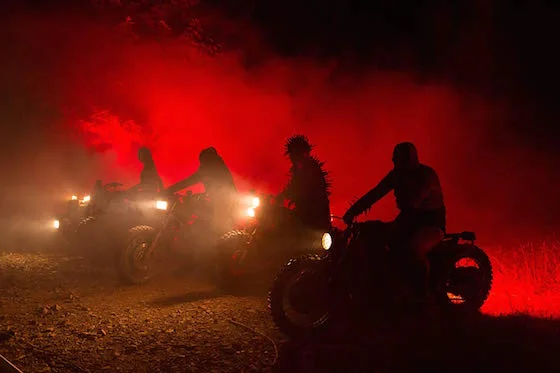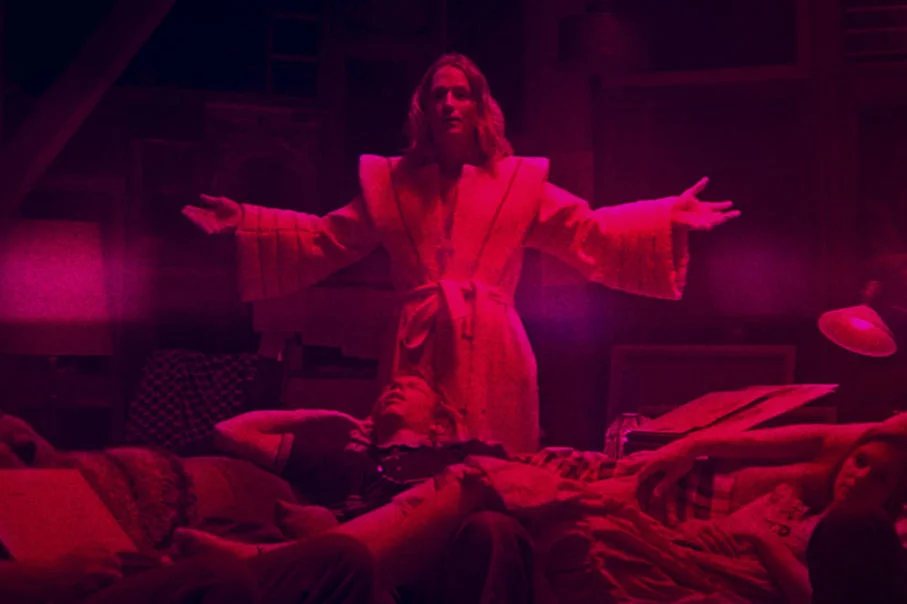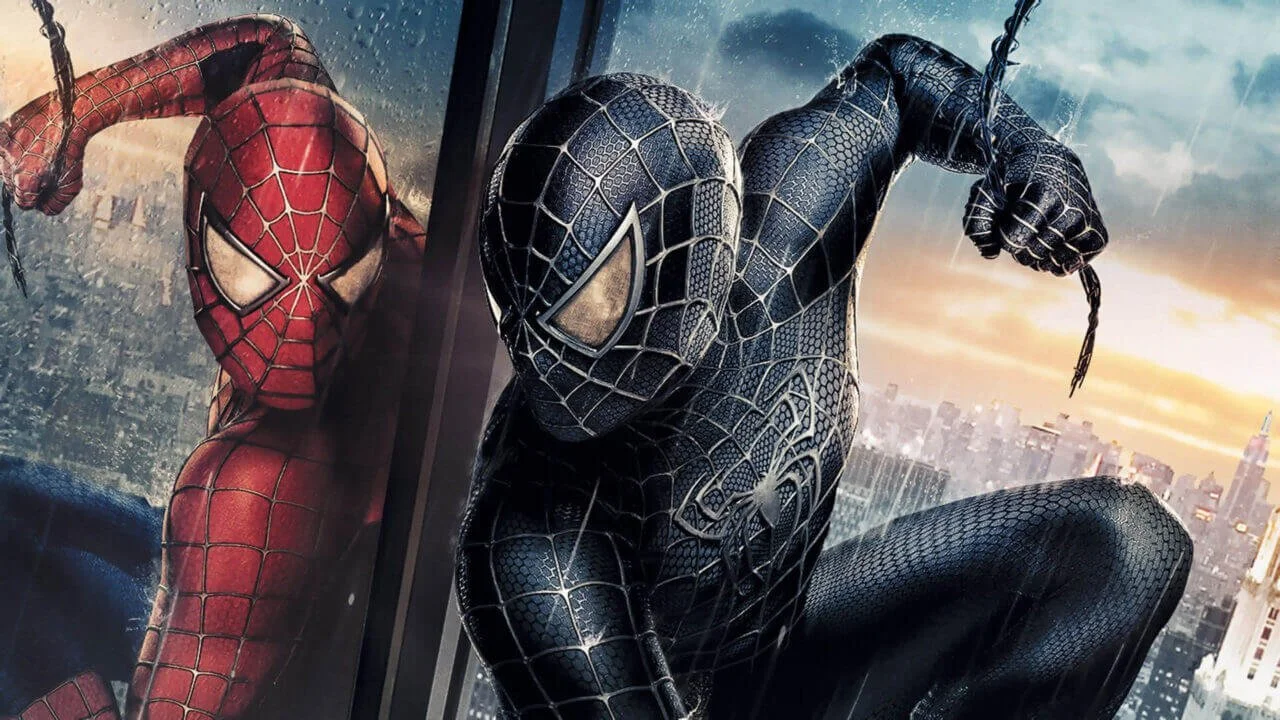WARNING: "Mandy" Contains Face-Melting Dragon Energy
There’s no point in writing a review for Mandy because it’s either a one-star movie or a five-star movie. It’s uncompromising in the extreme, in all of its depravity and beauty and horror. Anyone who walks out of Mandy feeling apathetic is an uncool buzzkill. It’s true, sorry.
Here is an important fact. Mandy is soaked in the colour red, from beginning to end. Which is the colour of blood. Which denotes life -- and death. Red also signifies love -- and hate. The first half of Mandy is about life and love. The second half, hate and death. Incidentally, Red is the name of main character, played by Nic Cage, and he loves just as hard as he hates. Maybe it’s not incidental. Maybe writer/director Panos Cosmatos is a muthafuckin’ mad man visionary who deeply cares about the visual craft of cinema. Maybe.
What I’m saying is that this simple tale of revenge is not just about revenge but about Everything. Instead of appraising Everything, I’m going to do whatever the writing equivalent is of basking in awe of something magical and wounded -- and metal as fuck. Please forgive the ramble-y quality.
Mandy’s premise is so simple it can be summed up in a sentence: Set in 1983 in the wilderness, Nic Cage plays a logger, Red, who wreaks vengeance upon a gang of drugged-up hippie Jesus freaks for gruesomely murdering his girlfriend Mandy. There aren’t twists and turns that spruce up the plot. To paraphrase the late great Roger Ebert, it’s not what it’s about but how it’s about it.
How is Mandy, uh, about it? Well. It can accurately be described as a trip. A journey from peaceful ethereal beauty to bug-fuck nuts blood-soaked revenge, fuelled by generous amounts of LSD and cocaine. The story’s path is clear to all who are familiar with the revenge narrative, yet it’s filled and populated with all sorts of strange textures and madness and sadness.
But what makes this descent into utter insanity so impactful is Mandy’s slow and peaceful and uneventful first half, which shows us Red and Mandy’s slow and peaceful and uneventful existence. She works as a part time illustrator and gas station cashier, he works a very physical job as a labourer. Their quiet life and tender conversations hint at a troubled past, but they’ve miraculously carved out a small measure of happiness together. You don’t know them that well but you’re happy for them. You can’t help but be; the hypnotic rhythms and pacing lulls you.
This ethereal atmosphere thickens and poisons when we’re introduced to the Charles Manson-esque Jeremiah Sand and his deranged religious cult. They are so unsettling a presence that they warp the fabric of Mandy itself, with Johann Johansson’s score subtly taking on the qualities of a predator raring to strike. Jeremiah Sand, like Charles Manson, is a pathetic egoist and failed musician.
He becomes obsessed with possessing Mandy, and with the help of his dim-witted and drugged out disciples, he soon does. He kidnaps Mandy and Red, drugs Mandy and exposes himself to her, in all of his literal and figurative smallness. He says he’s special and she’s special. How about they be special together?
What else can she do but laugh? She laughs and laughs and laughs. It’s a chilling laugh, filled with venom and hate. Enraged and hurt and afraid, he sets her on fire, right in front of Red. Here I was reminded of a pertinent Margaret Atwood quote: “Men are afraid women will laugh at them. Women are afraid men will kill them”.
The second half drastically switches gears and tone. Mandy’s death is so destabilising that it’s as if the movie begins to lose its grip on reality, as it drips and gushes with more and more imagery inspired by Heavy Metal album covers and adult fantasy art. Cosmic fantasy bleeds in, the colours become far more exaggerated and vibrant. There’s even some creepy animation playing on a loop in Red’s broken mind. However, lest you think Mandy gets as frenetic as a heavy metal song, the pacing and mood remains deliberate and meditative even during the most outlandish scenes of smoky, hell-on-earth chainsaw duelling (yeah; fucking chainsaw duelling) and Nic Cage’s Red forging a mighty battle axe fit to slay Satan.
The battle axe gleams fiercely and will satiate any cinephile hungry for dope imagery, yes, but it’s grief and rage made tangible. It’s a Rosetta Stone for Mandy, where every gory, bloody revenge kill is simultaneously pure ecstasy and a step toward irreversible dehumanisation. Literally, I did not know whether to cheer Red on or weep for him. I wanted to do both. This dissonance is confronting and not conducive to a mindlessly fun midnight movie-esque experience. It provoked some nervous titters of laughter in the theatre. He surely gives the performance of his lifetime here, animalistic and tender in all the right places.
Wait, wait. There’s this one scene I have to talk about. Whew. Okay, so, Red battles demonic bikers – one who’s sporting an erect literal blade dick after snorting a pile of cocaine -- in their grubby little kitchen while blaring pornography provides the only very sad light source; sad depressing reality and dark awesome as hell fantasy madness co-existing in the same scene – Mandy in a nutshell. After brutally conquering the demonic bikers, Red partakes in some of their cocaine, sniffing it off of a jagged shard of glass. Then he has a slight taste of their super-duper face-melting hallucinogen to ready himself to complete his righteous revenge quest.
Fuckin’ A. C’mon. This is amazing. And this should only exist in some shabby exploitation flick. But writer/director Panos Cosmatos is an artisan. Not one frame of Mandy goes by without his psychological fingerprints all over it. Of that I’m sure of. The erect blade dick, Red’s descent into dehumanisation commensurate with the violence he dishes out, the petty egotistical man who brutally kills a woman for rejecting and laughing at him…it adds up to a damning indictment of something you can piece together yourself.
Really though, I can’t say I didn’t take a huge amount of pleasure in the masculine violence of it all. Does Mandy contradict itself, then? If so, cool; it’s imperfection in this regard only makes it more worthwhile as a piece of art. Maybe it is as jagged and roughly-hewn as a dirty nugget torn from a deeply troubled sub-conscious. Maybe more of this kind of art in cinema is what I want.
I’m only scratching the surface, of course. More viewings will reveal deeper meanings. For now, I’m just slack jawed and in awe. Mandy is deadly serious about loss and it conjures the kind of blackly ridiculous, balls-out campy imagery that puts other action/arthouse flicks to shame. Its influences are obvious, but it’s a one of a kind. Find a way to see this one, because it’s not getting the wide release it deserves.












